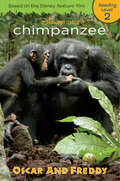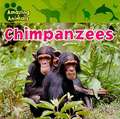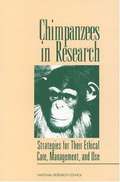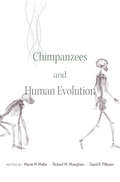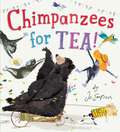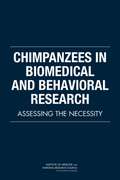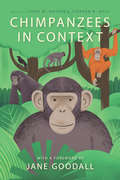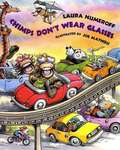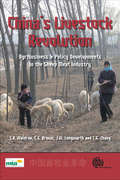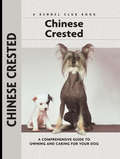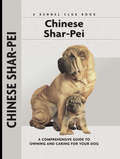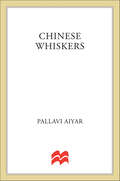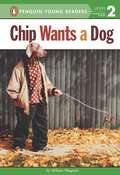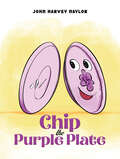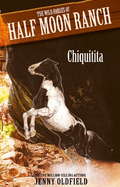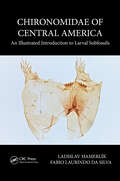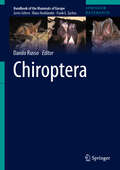- Table View
- List View
Chimpanzee: Lessons from our Sister Species
by Kevin D. HuntThe chimpanzee is one of our planet's best-loved and most instantly recognisable animals. Splitting from the human lineage between four and six million years ago, it is (along with its cousin, the bonobo) our closest living relative, sharing around 94% of our DNA. First encountered by Westerners in the seventeenth century, virtually nothing was known about chimpanzees in their natural environment until 1960, when Jane Goodall travelled to Gombe to live and work with them. Accessibly written, yet fully referenced and uncompromising in its accuracy and comprehensiveness, this book encapsulates everything we currently know about chimpanzees: from their discovery and why we study them, to their anatomy, physiology, genetics and culture. The text is beautifully illustrated and infused with examples and anecdotes drawn from the author's thirty years of primate observation, making this a perfect resource for students of biological anthropology and primatology as well as non-specialists interested in chimpanzees.
Chimpanzee: Oscar and Freddy
by Disney PressBased on the Disneynature film Chimpanzee, this early reader uses simple text and engaging photographs to introduce readers to an inspiring story about family set in the African rainforest.
Chimpanzees (Amazing Animals)
by Sarah AlbeeDid you know that chimpanzees are more similar to humans that any other animal on Earth? Highly intelligent and social, chimps can make tools and even communicate with sign language. Learn all about these wonderful creatures-what they eat, how they raise their young, and how they interact with one another.
Chimpanzees (Nature's Children)
by Caroline GreenlandThis book offers fascinating facts and information on the two types of Chimpanzees in the wild. Describes how they use tools in hunting, communicate socially, live in groups, made nests and raise young.
Chimpanzees In Research: Strategies For Their Ethical Care, Management, And Use
by Committee On Long-term Care Of ChimpanzeesThe National Academies Press (NAP)--publisher for the National Academies--publishes more than 200 books a year offering the most authoritative views, definitive information, and groundbreaking recommendations on a wide range of topics in science, engineering, and health. Our books are unique in that they are authored by the nation's leading experts in every scientific field.
Chimpanzees and Human Evolution
by Martin N. MullerKnowledge of wild chimpanzees has expanded dramatically. This volume, edited by Martin Muller, Richard Wrangham, and David Pilbeam, brings together scientists who are leading a revolution to discover and explain human uniqueness, by studying our closest living relatives. Their conclusions may transform our understanding of human evolution.
Chimpanzees for Tea!
by Jo EmpsonA silly, fun version of the game "telephone"—in which a grocery list committed to memory goes playfully awry. One day, Vincent's mother asks him to go to the store to pick up a few items: "a bunch of carrots, a box of rice, some China tea, a big, firm pear, and a tin of peas" to be precise. "And hurry home in time for tea!" she says. Sounds easy enough.Yet distractions are at every turn, causing havoc with Vincent's memory. All of a sudden, a tin of peas is replaced by a trapeze; a big, firm pear becomes a big furry bear; and a box of rice transforms into a box of mice!Needless to say, Vincent's mother is in for quite a surprise.Told with a playful rhythm for reading aloud and illustrated with exuberance and great child appeal, this humorous picture book will have kids laughing and asking for repeated readings.Praise for Chimpanzees for Tea!"British author-illustrator Jo Empson brings her wonderfully freewheeling, kinetic style to this lively read-aloud that will have youngsters giggling and shouting out the correct items from the list."—Shelf Awareness"Award-winning British author/illustrator Empson energetically illustrates her tale of ever more outrageous memory lapses with scribbly watercolors full of swooping action and bouncing wildlife that follow the swirling text across the pages. As much fun to read as it is to hear, and a real treat for the eyes."—Kirkus Reviews"With a wildly cavorting cast of characters [and] a playful text . . . this is hard to resist." —Booklist"The humorous text makes this a perfect read-aloud for all ages and a great memory game to play with school-age kids."—School Library Journal
Chimpanzees in Biomedical and Behavioral Research
by Bruce M. AltevogtFor many years, experiments using chimpanzees have been instrumental in advancing scientific knowledge and have led to new medicines to prevent life-threatening and debilitating diseases. However, recent advances in alternate research tools have rendered chimpanzees largely unnecessary as research subjects. The Institute of Medicine, in collaboration with the National Research Council, conducted an in-depth analysis of the scientific necessity for chimpanzees in NIH-funded biomedical and behavioral research. The committee concludes that while the chimpanzee has been a valuable animal model in the past, most current biomedical research use of chimpanzees is not necessary, though noted that it is impossible to predict whether research on emerging or new diseases may necessitate chimpanzees in the future.
Chimpanzees in Context: A Comparative Perspective on Chimpanzee Behavior, Cognition, Conservation, and Welfare
by Lydia M. HopperThe study of the chimpanzee, one of the human species’ closest relatives, has led scientists to exciting discoveries about evolution, behavior, and cognition over the past half century. In this book, rising and veteran scholars take a fascinating comparative approach to the culture, behavior, and cognition of both wild and captive chimpanzees. By seeking new perspectives in how the chimpanzee compares to other species, the scientists featured offer a richer understanding of the ways in which chimpanzees’ unique experiences shape their behavior. They also demonstrate how different methodologies provide different insights, how various cultural experiences influence our perspectives of chimpanzees, and how different ecologies in which chimpanzees live affect how they express themselves. After a foreword by Jane Goodall, the book features sections that examine chimpanzee life histories and developmental milestones, behavior, methods of study, animal communication, cooperation, communication, and tool use. The book ends with chapters that consider how we can apply contemporary knowledge of chimpanzees to enhance their care and conservation. Collectively, these chapters remind us of the importance of considering the social, ecological, and cognitive context of chimpanzee behavior, and how these contexts shape our comprehension of chimpanzees. Only by leveraging these powerful perspectives do we stand a chance at improving how we understand, care for, and protect this species.
Chimpanzees of the Lakeshore
by Toshisada NishidaChimpanzees are humanity's closest living relations and are of enduring interest to a range of sciences, from anthropology to zoology. In the West, many know of the pioneering work of Jane Goodall, whose studies of these apes at Gombe in Tanzania are justly famous. Less well-known, but equally important, are the studies carried out by Toshisada Nishida on the eastern shore of Lake Tanganyika. Comparison between the two sites yields both notable similarities and startling contrasts. Nishida has written a comprehensive synthesis of his work on the behaviour and ecology of the chimpanzees of the Mahale Mountains. With topics ranging from individual development to population-specific behavioural patterns, it reveals the complexity of social life, from male struggles for dominant status to female travails in raising offspring. Richly illustrated, the author blends anecdotes with powerful data to explore the fascinating world of the chimpanzees of the lakeshore.
Chimps Don't Wear Glasses
by Laura Joffe NumeroffThe team that created the daffy "Dogs Don't Wear Sneakers" returns with another silly selection of preposterous predicaments for animals. Camels don't sing and pandas don't pole vault--unless, of course, you close your eyes and draw with your mind. Picture descriptions on picture only pages.
China's Livestock Revolution: Agribusiness and Policy Developments in the Sheep Meat Industry
by Scott Waldron Colin Brown John Longworth Zhang CungenThis book focuses on the growing sheep meat industry while drawing on associated research from other areas of the Chinese livestock section. Using this research, the authors use the sheep meat industry case study to illustrate the broader trends that apply more generally to the Chinese livestock sector, especially in the case of ruminant livestock.
Chinchillas
by Donna AnastasiThe delightful South American "unrodent-like rodent" known as the chinchilla makes a playful and affectionate companion animal. Author Donna Anastasi refers to them as "inquisitive, sensitive, intelligent, and active," the ideal combination of intelligence and interaction anyone would want in a small pet.This Complete Care Made Easy title is an ideal introductory pet guide about the chinchilla, with detailed chapters on characteristics, selection of a healthy chinchilla, housing and care, welcoming and taming the new arrival, feeding and daily care, training, and health and veterinary care. The book offers excellent advice about feeding and nutrition, including the choice of pellets, supplements, hay, and treats.The chapter "Understanding and Training Your Chinchilla" explains the abilities and limitations of chinchillas' senses (they're nearsighted but have exceptional hearing) and offers a great overview of how they communicate through sounds and body language. With positive reinforcement and a clicker (no leash and collar!), the chin can be trained to perform tricks for the family's entertainment, and the book gives lots of training pointers for owners! For chin fanciers who are interested in further exploration, the author includes chapters on breeding chinchillas and getting involved in chin shows. Sidebars throughout the text provide useful information to chinchilla keepers, covering such topics as chin colors, harmful human foods, daily care checklist, and show terminology. The resources include chinchilla societies, books and websites. Glossary of terms and index included.
Chinese Crested
by Isabelle Francais Carol Ann Johnson Juliette CunliffeThe world's most beloved hairless dog, the Chinese Crested is distinctive for his near-nakedness, his (sometimes) lavender skin coloration, and his graceful miniature pony outline. Whether hairless with tufts of flowing hair on his feet, head, and tail or coated (referred to as Powderpuff), the Chinese Crested makes a loyal, enthusiastic companion for anyone clever enough to fall under the spell of this elegant toy breed. Author Juliette Cunliffe provides insightful chapters on the breed's history, the evolution of hairless dogs, and the characteristics that make the Chinese Crested such a unique dog among dogs.New owners will welcome the well-prepared chapter on finding a reputable breeder and selecting a healthy, sound puppy. Chapters on puppy-proofing the home and yard, purchasing the right supplies for the puppy as well as house-training, feeding, and grooming (of skin and coat) and tooth care are illustrated with photographs of handsome adults and puppies. In all, there are over 135 full-color photographs in this useful and reliable volume. The author's advice on obedience training will help the reader better mold and train into the most well-mannered dog in the neighborhood. The extensive and lavishly illustrated chapter on healthcare provides up-to-date detailed information on selecting a qualified veterinarian, vaccinations, preventing and dealing with parasites, infectious diseases, and more. Sidebars throughout the text offer helpful hints, covering topics as diverse as historical dogs, breeders, or kennels, toxic plants, first aid, crate training, carsickness, fussy eaters, and parasite control. Fully indexed.
Chinese Shar-Pei
by Juliette CunliffeOne of the world's most peculiar dogs, perhaps, is the Chinese Shar-Pei, known for distinctive wrinkles, his blue black tongue, and his extremely harsh coat. Few dogs have as fascinating a history as the Chinese Shar-Pei, an ancient breed rescued from the precipice of extinction in the mid 20th century. Devoted fans of the Shar-Pei describe the breed as affectionate, protective, independent, and calm. This Comprehensive Owner's Guide gives newcomers to the Shar-Pei all of the necessary information about socializing and training the Shar-Pei, preventing and handling potential health issues, and evaluating the compatibility of the breed to a new owner's expectations and life style. Author Juliette Cunliffe paints a realistic and revealing portrait of this extraordinary breed that requires an attentive, dog-smart owner to thrive., an account that all lovers of the breed will appreciate for its insight and candor.New owners will welcome the well-prepared chapter on finding a reputable breeder and selecting a healthy, sound puppy. Chapters on puppy-proofing the home and yard, purchasing the right supplies for the puppy as well as house-training, feeding, and grooming are illustrated with photographs of handsome adults and puppies. In all, there are over 135 full-color photographs in this useful and reliable volume. The author's advice on obedience training will help the reader better mold and train into the most well-mannered dog in the neighborhood. The extensive and lavishly illustrated chapter on healthcare provides up-to-date detailed information on selecting a qualified veterinarian, vaccinations, preventing and dealing with parasites, infectious diseases, and more. Sidebars throughout the text offer helpful hints, covering topics as diverse as historical dogs, breeders, or kennels, toxic plants, first aid, crate training, carsickness, fussy eaters, and parasite control. Fully indexed.
Chinese Whiskers
by Pallavi AiyarChinese Whiskers by Pallavi Aiyar is a charming fable set against the landscape of contemporary Beijing, seen through the eyes of two cats.Soyabean is a middle class cat looked after by a grandmother who embodies traditional Chinese morality. Tofu is born to a stray cat mother in a backyard dustbin. They are brought together when they are adopted by foreigners, who live in a traditional style courtyard house in Beijing's traditional hutong neighborhoods. Then Soyabean is offered a job as a model for a new brand of cat food while at the same time a mysterious virus is sickening people across the city. Cats are blamed for it and are being rounded up, and Soyabean and Tofu's idyllic lives as pampered pets come to an abrupt end. Interweaving real episodes in recent Chinese history such as the Olympic Games, the SARS virus, and tainted pet-food scandals with a richly imagined world, this heartwarming story of cats and humans does what W. Bruce Cameron's A Dog's Purpose did for canines. It will make you laugh and tear up, while showing the battles fought between the corruption of modern living and the ideals of traditional life.
Chip 'n' Dale at the Zoo
by Disney Book GroupOne summer day, chipmunks Chip and Dale gather acorns for the winter ahead. But when they stumble upon a delicious new snack (a peanut!), they look around and see that they're near the zoo! Even better, people at the zoo are tossing peanuts to the animals! So when Chip and Dale take some peanuts from Dolores the elephant, she follows the chipmunks to retrieve her snack. Don't miss this hilarious story as Chip and Dale try to prepare for the winter!
Chip Wants a Dog (Penguin Young Readers, Level 2)
by William WegmanChip has dreamed about owning a dog since he was a baby. A dog would be his best friend, for he would teach it to sit, stay, fetch, and roll over. But Chip's parents refuse to buy him one. One night, Chip's dream reveals a deep truth about who Chip is. Chip doesn't need a dog; he is a dog! From then on, his life is changed--he takes himself for walks; teaches himself to sit, stay, and fetch; and makes plenty of neighborhood friends!
Chip the Dam Builder
by Jim KjelgaardWhen disaster struck the beaver colony, Chip, the wise old leader, started out in search of a new home. It was a perilous journey, filled with danger from man and beast. But old Chip won through, to build another home for his faithful mate and their new family of kits. The beaver pond became a center of wilderness activity. It was a refuge for Trim, the deer, and her little fawn, for King, the trout, and his offspring, for geese and muskrats and frogs. It was also a hunting ground for Wraith, the horned owl, for Ripple, the otter, and above all, for Glare, the lynx, who tried once too often to catch Chip, the old dam builder.
Chip the Purple Plate
by John Harvey NaylorA story to demonstrate to ‘pre-teens’ that no matter how things seem to become almost impossible as they enter adolescence, and the inevitability of troubling times, there is always going to be a bright side, even if they do take a few knocks along the way.
Chip: The Story of a Guide Dog Puppy
by Miss Barlow's Fourth through Sixth Grade Special Education Students in Clovis CaliforniaFrom the Book jacket: Chip, The Story of a Guide Dog Puppy, chronicles the life of a guide dog from birth at the kennels to what happens if it does not make it as a working guide dog. Each year the learning handicapped students at Jefferson Elementary School in Clovis, California, welcome a puppy into their classroom to help their teacher socialize it for Guide Dogs for the Blind, Inc. The students wrote and illustrated this award-winning book. Meet the Authors and Illustrators L-R: Brandon Linn, Juston Smart, Megan Johnson, Hazael Gonzalez, Jordan Kedwards, Margaret Maskovich, Dominic Espinoza, Bonnie Jones, Chad Powers, and Hailey Ricord.
Chipmunks (Nature's Children)
by Merebeth SwitzerWhat's a chipmunk's home like? What do chipmunks eat? How do chipmunks survive winter? Find the answers to these questions, and learn much more about the physical characteristics, behavior, habitat, and life of chipmunks.
Chiquitita: Book 3 (Wild Horses #3)
by Jenny OldfieldChiquitita is a young mare taken from the wild herd to be tamed and worked without force. The method demands amazing patience and gentleness from Kirstie and Lisa's host, Wayne Raburn. But Wayne's ranch hand, Walter, secretly uses harsher methods which soon ruins his boss's good work. Kirstie exposes Walter, who loses his job. But now he wants revenge - and he's planning to take it out on the horse...
Chironomidae of Central America: An Illustrated Introduction To Larval Subfossils
by Ladislav Hamerlik Fabio Laurindo da SilvaThis illustrated introduction to Central American Chironomidae offers extensive photographic material, as well as detailed morphological and ecological descriptions of chironomid subfossils found in Central American lake sediments. The book uniquely provides two identification keys: one for living larvae occurring (or potentially being present) in Central America and one for the recorded subfossil remains, using limited morphological characters. Paleolimnological investigations using chironomid remains have undergone a resurgence of interest, and this taxonomic guide will aid the thorough analysis of the diversity and distribution of the taxa encountered to date in Central America. Out of the total 64 described genera, the book brings 20 endemic genera, and more than half of the presented morphotypes are new. Plates are included for each taxon with generic characters and also provide a key to morphotypes, if present, their specific characters, distribution, and ecology. Authored by a (paleo)limnologist and a taxonomist, the guide draws on a thorough taxonomical knowledge of the region’s recent chironomid fauna. It uses a paleolimnological approach to transmit this information to morphotypes that can be linked with ecology and used to reconstruct the past development of nature. The book thus helps paleo-workers and taxonomists to learn more about these fascinating insects and, through them, to discover the world around us. Providing a comprehensive reference for aquatic ecologists, paleolimnologists, students, and researchers, the guide will also be of interest to non-academic professionals working on applied research and biomonitoring of lakes. It will be useful for people studying both recent and subfossil material, not only in Central America, but in the whole Neotropical region.
Chiroptera (Handbook of the Mammals of Europe)
by Danilo RussoPreliminaryThis volume provides comprehensive overviews of each European bat species’ biology including palaeontology, physiology, genetics, reproduction and development, ecology, habitat, diet, mortality and age determination. Their economic significance and management, as well as future challenges for research and conservation are also addressed. Each chapter includes a distribution map, a photograph of the animal and key literature. This authoritative volume of the Handbook of the Mammals of Europe is a timely and detailed compilation of all European bats and will appeal to academics, students and professionals in mammal research.

